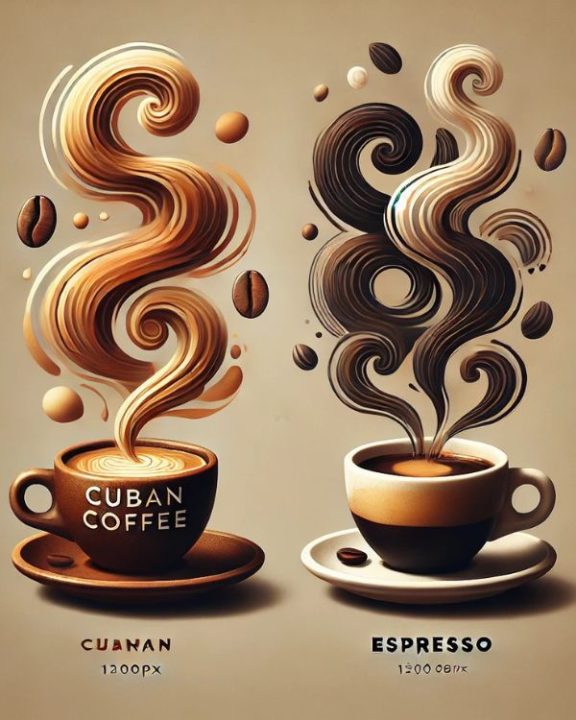Come along on a fun trip to learn about Cuban coffee. It has yummy flavors and old customs. People all over the world love Cuban coffee, from Miami to Cuba.
You’ll taste the perfect mix of dark roast coffee, sugar, and tradition in every cup. Enjoy making a cafecito Cubano or try a creamy cafe con leche. Let’s learn about Cuban coffee vs espresso and brewing the best Cuban coffee and the cool culture that comes with it.
What is the difference between Cuban coffee and espresso? The big difference between Cuban coffee and espresso is how they are made. Espresso is made by pushing hot water through ground coffee beans. On the other hand, Cuban coffee adds sugar while brewing. This makes it sweet and foamy.
Cuban Coffee Vs Espresso: Brief Description
Cuban coffee and espresso are both strong drinks, but they are different. Cuban coffee is sweet because it uses sugar when made.
This creates a creamy foam called despumate, which gives Cuban coffee its special texture and sweetness. Espresso can be bitter in comparison. The sugar in Cuban coffee makes it sweet and gives it a smooth and round taste.
Best Cuban Coffee
When we talk about the best Cuban coffee, some brands are popular with coffee lovers. Cafe Bustelo is a favorite because it has a strong taste and smells great.
It is made from a special mix of dark-roasted coffee beans. With Cafe Bustelo, you get a strong and delicious cup that shows what Cuban coffee is all about.
Cafe La Llave is a great choice if you want a real Cuban coffee experience. This brand sticks to its roots. It uses a special mix of Cuban ground coffee beans that are roasted perfectly to balance bitterness and sweetness.
The name Cafe La Llave means “the Key,” which brings out Cuban coffee’s true flavors.
Cuban Espresso Shots
Cuban espresso shots are very important to Cuban coffee culture. These strong and tasty shots usually come from a stovetop espresso maker, also known as a moka pot, which is common in homes in Cuba. What makes Cuban espresso special is that sugar is added right from the start.
As the coffee brews, it goes through sugar, creating a sweet and rich syrup. This makes the espresso both strong and delicious. It shows how much Cubans love their bold flavors and strong coffee.
People enjoy Cuban espresso in many ways. Some take it for a quick boost, while others like to sip it slowly. Making and drinking Cuban espresso is a special part of life that reflects the lively spirit of Cuban culture.
Espresso-Based Drinks
The magic of espresso is more than just a shot. It leads to many espresso drinks that make taste buds happy all over the world. From the cozy warmth of a latte to the rich treat of a cappuccino, each drink gives a unique and delicious experience for coffee lovers.
A latte has a lot of steamed milk, making it creamy and comforting while letting the strong flavors of espresso shine. A cappuccino mixes espresso, steamed milk, and fluffy milk foam perfectly, creating a mix of textures and flavors.
Espresso Drink Variations
The world of espresso drinks has many different kinds to try. From the simple Americano to the rich Mocha, there’s a drink for everyone. Here are some popular espresso drinks that people love:
- Americano: This classic drink mixes a shot of espresso with hot water. It’s milder but still tasty, perfect for those who like a lighter espresso taste.
- Mocha: Enjoy the chocolaty goodness of a Mocha. It combines delicious chocolate syrup, strong espresso, and steamed milk. It’s topped with whipped cream for a great treat.
- Cortado: If you want a stronger espresso flavor, try the Cortado. It has a shot of espresso with a small amount of steamed milk, making it a bold and tasty drink.

Is Cuban Coffee Stronger Than Espresso?
Many people argue about whether Cuban coffee is stronger than espresso.
Both types of coffee have strong flavors, but how strong they taste depends on how they are made.
A stovetop espresso maker is used to prepare Cuban coffee. It usually has a finer grind and more coffee compared to water, which makes it very strong.
Conversely, an espresso machine is used to make espresso. This device grinds coffee beans coarsely and pushes hot water through them. Espresso usually has more caffeine per ounce.
However, because Cuban coffee is served in smaller sizes and made differently, some people may think it is stronger.
Ultimately, how strong they taste is based on personal preference and the way they are brewed.
How Strong Is Cuban Coffee?
Cuban coffee is very strong. It can be as strong as espresso. This is because it is made with a stovetop espresso maker, which makes a thick brew.
The coffee beans are ground very finely, and there is a lot of coffee compared to the water, which makes the flavor strong.
When it comes to caffeine, Cuban coffee has a moderate amount. It is similar to a shot of espresso. But remember, the caffeine amount can change depending on the beans, brewing time, and serving size.
Is Cuban Coffee Good For You?
Moderate use of Cuban coffee is beneficial to your health. It has antioxidants that protect your cells.
Studies show that coffee may lower your risk of health problems like type 2 diabetes, Parkinson’s disease, and Alzheimer’s disease.
But be careful with sugar in Cuban coffee. Too much sugar can be bad for you. You can try a less sweet option like café con leche, which has more milk.

Whether Cuban coffee is good for you depends on your health, diet, and how much you drink. Consult a medical professional for guidance specific to your requirements. Enjoy this tasty drink in moderation as part of a healthy lifestyle.
Understanding The Origins Of Cuban Coffee And Espresso
Cuban coffee and espresso taste strong and bold. They come from different places and have special meanings in their cultures.
Cuban coffee began in Cuba in the 18th century when Spanish colonists brought coffee plants. It became a special way to brew coffee that is now important in Cuban life. This style shows the rich history and love for strong coffee in Cuba.
The Origins And Cultural Significance Of Cuban Coffee
Cuban coffee is very important in Cuban culture. It has been around since the 18th century when coffee started being grown in Cuba. People in Cuba love to drink this coffee.
You can smell Cuban coffee in places like Havana and Little Havana in Miami. It brings people together to enjoy special moments. People drink it at home with family or at cafes with friends. Cuban coffee helps us feel connected to each other.
The Traditional Preparation Method Of Cuban Coffee
The classic way to make Cuban coffee is very important for getting its special taste. To start, you need a moka pot. This stovetop espresso maker is a big part of Cuban coffee culture. It uses pressure to make a strong and tasty cup of coffee.
You should use finely ground dark-roasted coffee. This is usually a mix of Arabica and Robusta beans. Put this coffee in the moka pot’s filter basket. Then, add water to the bottom.
Place the pot over medium heat on the stove. As the water heats up, it makes steam pressure. The hot water is forced through the coffee grinds by this pressure. This gets rich flavors and makes a strong brew.
The Unique Preparation Method Of Cuban Coffee With Sugar
What makes Cuban coffee special is how sugar is added while it brews. This important step gives Cuban coffee its sweet taste and the foamy layer called espumita.
When the dark and rich coffee starts brewing in the moka pot, a small amount of sugar, usually one or two tablespoons, is put in the top chamber.
This sugar mixes with the first few drops of brewed coffee to form a thick syrup. As the rest of the coffee brews, it passes through this sweetened liquid.
This process makes the coffee strong but also very sweet and creamy. This unique texture makes it different from any other coffee experience.

Flavor Profile Of Cuban Coffee Due To The Sugar-Sweetening Process
The sugar-sweetening process is very important for the special taste of Cuban coffee.
It adds sweetness and makes the flavor richer and more interesting. Usually, people use white sugar, but some like to use brown sugar for extra flavor.
When the moka pot heats up, it makes the sugar lightly caramelize. This creates hints of caramel and toffee in the coffee.
This caramelization, along with the deep flavors of dark-roasted coffee beans, gives a taste that is flavorful and fun.
Espresso: A Staple In Italian Coffee Culture
Espresso is really important in Italian coffee culture. It’s not just a drink; it’s a way of life in Italy. Italian people love strong coffee and tradition. They also like nice things.
In busy cafes in Rome and cozy squares in Florence, the smell of fresh espresso is everywhere. This smell tells people to enjoy the drink.
Espresso is good in the morning, afternoon, or after a meal. It is a big part of Italian culture. It shows warmth, connection, and the simple joy of having a well-made cup of coffee.
The Brewing Process And Characteristics Of Espresso
Brewing espresso is like making magic coffee. It gives you a strong and yummy shot of coffee. First, you need finely ground dark-roasted coffee beans.
Usually, these are a mix of Arabica and Robusta beans. You’ll then press the coffee grounds into the portafilter of an espresso machine.
Next, hot water heats to just the right temperature and is pushed through the coffee grounds at high pressure. This process takes only a few seconds.
The result is a shot of espresso with a special layer on top known as crema. This creamy layer shows off the espresso’s rich and yummy flavors.
Comparing The Flavor Profiles Of Cuban Coffee And Traditional Espresso
Cuban coffee and traditional espresso taste different because of how they are made and their cultural background.
Cuban coffee is sweeter and has a caramelized taste because sugar is added while brewing. This sugar helps create a smooth flavor that balances the bitterness of the dark-roasted coffee beans.
On the other hand, traditional espresso has a more intense and bitter taste. It does not use sugar during brewing, allowing the natural flavors of the coffee beans to come out.
Espresso is usually served in smaller amounts, giving a strong caffeine boost and bold flavors that stay on your taste buds.
A Comparison Of Caffeine Content Between Cuban Coffee And Espresso
When we talk about caffeine, both Cuban coffee and espresso give you a good energy boost.
The amount of caffeine can change depending on things like the type of coffee beans, how long you brew it for, and how big the serving is.
When we talk about caffeine, both Cuban coffee and espresso give you a good energy boost.

The amount of caffeine can change depending on things like the type of coffee beans, how long you brew it for, and how big the serving is.
Espresso often contains more caffeine than Cuban coffee per ounce. However, a regular cup of Cuban coffee is often larger than one shot of espresso. This can balance out how much caffeine you end up getting.
Here is a quick comparison:
- Cuban Coffee: 4 ounces, 50-80 milligrams of caffeine
- Espresso: 1-2 ounces, 60-100 milligrams of caffeine
In the end, the best choice for a caffeine boost depends on personal preference and how strongly you like it.
Tips For Brewing Authentic Italian Espresso
For those who want to make real Italian espresso at home, follow these easy tips. First, choose the right coffee beans. Look for freshly roasted, finely ground espresso blends made for espresso.
Get a good espresso machine that lets you control water temperature and pressure. These are important for making a perfect espresso. Additionally, make sure the powder is as finely ground as table salt.
Try different amounts of pressure when tamping for an even extraction. For optimal flavor, use filtered, fresh water. With practice and care, you can brew authentic Italian espresso at home.
Differences In Serving Size And Presentation Between The Two Beverages
When we have Cuban coffee or espresso, it’s important how much we get and how it looks.
Cuban coffee is typically served in little ceramic or porcelain cups. These cups hold about 2 to 4 ounces. This small size shows that the coffee is strong and is meant to be enjoyed slowly.
Espresso is also served in a small cup without a handle, called a demitasse, which holds 1 to 2 ounces. Espresso gives a quick and strong shot of caffeine and is often drunk in one or two sips.
Popular Variations And Recipes For Both Cuban Coffee And Espresso
The world of Cuban coffee and espresso has many tasty options for everyone. If you like Cuban coffee, you can try a Cortadito, which is Cuban espresso with a little steamed milk. Another delicious choice is a Café con Leche, which is Cuban coffee with hot milk.
For espresso lovers, there are classic options like a Latte with steamed milk, a Cappuccino with foamed milk on top, and an Americano, which is espresso mixed with hot water for a milder taste. If you have a sweet tooth, a Mocha with rich chocolate flavor is a great choice.
How To Make An Authentic Cuban Coffee Or Espresso At Home
Make Cuban coffee at home easily with just a few things. First, get a moka pot. This pot is used for making Cuban coffee. Use finely ground Cuban coffee, which is a mix of Arabica and Robusta beans.
Pour water into the moka pot’s bottom. Fill the filter basket with coffee grinds. Put the pot together and place it on the stove at medium heat.
Let the coffee brew until you hear a gurgling noise. While it’s brewing, take a tablespoon of sugar and mix it with a little hot water.
Whisk it well until you see a thick foam. When your coffee is ready, pour it into a cup and add the sugar foam on top. Enjoy your homemade Cuban coffee!

Pairing Suggestions For Enjoying Cuban Coffee And Espresso With Food
Cuban coffee and espresso taste are good with different snacks. Cuban coffee is sweet and goes well with pastries like guava pastelitos.
Espresso is bitter and goes nicely with chocolate desserts like dark chocolate torte or tiramisu.
Biscotti is crunchy and a little sweet, which is a good balance with espresso.
Health Benefits And Considerations Of Consuming Cuban Coffee Vs Espresso
Coffee is good for you when you don’t have too much. Cuban coffee vs espresso has good things called antioxidants.
These can help your cells and might lower your chances of getting some diseases that last a long time.
Drinking coffee is linked to having a lower chance of type 2 diabetes, Parkinson’s disease, and Alzheimer’s disease.
But remember, it’s important to not have too much. Too much caffeine can make you feel anxious, have trouble sleeping, and have stomach problems.
Be careful with the sugar in Cuban coffee, as it can make you gain weight and have other health problems.
In the end, enjoy Cuban coffee and espresso as part of a healthy diet. If you’re worried, talk to a healthcare professional.
FAQ About Cuban Coffee Vs Espresso
Is Cuban Coffee Stronger Than Espresso?
Espresso usually has more caffeine in each ounce. However, Cuban coffee is often brewed using a stovetop espresso maker. This coffee is made stronger by adding more coffee grounds and using a slightly different process. As a result, it has a very strong flavor and a caffeine level that is close to espresso.
What Makes Cuban Coffee Different?
Cuban coffee is special mainly because of how it uses sugar in the brewing process. It is usually made with a moka pot. The coffee is brewed with sugar, which creates a thick, sweet foam called espumita on top. Different Cuban coffee brands use different blends of coffee beans.
Is Café Cubano The Same As Espresso?
Cafe Cubano is the Cuban form of espresso. It is usually made with a moka pot, but you can also use other espresso machines. The key difference is that sugar is added while brewing.
Does Cuban Coffee Have More Caffeine?
The caffeine in Cuban coffee and espresso is almost the same. The caffeine content in espresso is somewhat higher per ounce. But, Cuban coffee is usually served in larger cups and is very strong. So, the total caffeine you get from both is similar.
Final Thought
Drinking Cuban coffee is more than just having a cup of coffee. It is like experiencing a piece of culture. In this blog post, we’ve discussed Cuban coffee vs espresso.
When you use the moka pot to brew it and add the sweet cafe con leche, each sip can make you feel like you are walking the busy streets of Havana or sitting in a cozy cafe in Little Havana.
The combination of dark roast coffee, foam, and brown sugar creates delicious flavors that can make you feel refreshed and happy. Try Cuban coffee and let its warmth make you feel good.





Leave a Reply